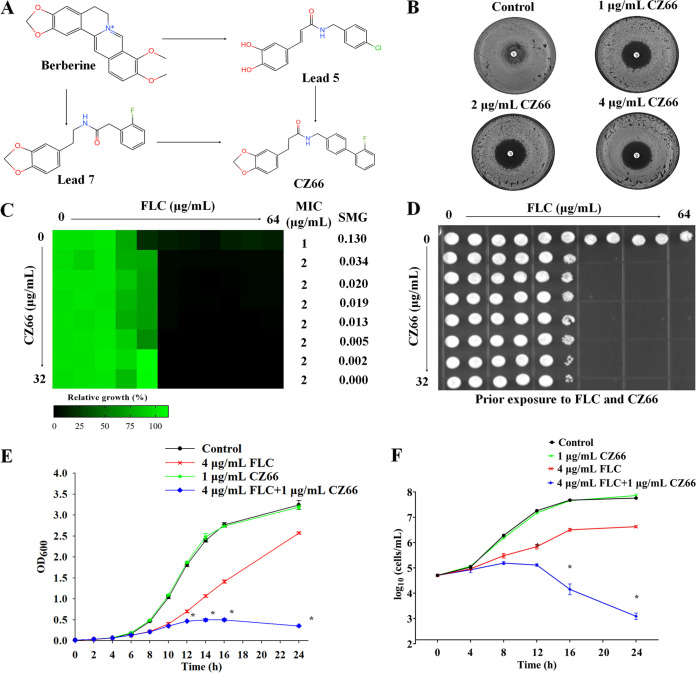FIG 1.
CZ66 makes FLC fungicidal. (A) Chemical structural formula and design of CZ66. (B) Disk diffusion assays showed that different concentrations of CZ66 (1, 2, and 4 μg/mL) made the zones of inhibition of 25 μg FLC clear. In brief, cells (2 × 105 cells) were spread onto YPD plates or YPD-containing CZ66 plates. A single 25-μg FLC disk (6 mm) (Liofilchem, Italy) was placed in the center of each plate. Plates were then incubated at 30°C for 48 h before plates were photographed. (C) Dose-matrix titration assays showed that CZ66 (concentration range from 0.5 μg/mL to 32 μg/mL) abolished FLC tolerance of C. albicans incubated in YPD medium at 30°C for 48 h. (D) Cells from the dose-matrix titration assays were spotted onto YPD medium and incubated at 30°C for 48 h before plates were photographed. (E) Growth inhibition curve assays. Overnight C. albicans cultures were inoculated into 100 mL of fresh YPD medium with 4 μg/mL FLC, 1 μg/mL CZ66, or 4 μg/mL FLC and 1 μg/mL CZ66 or without any compound (control) to a final OD600 of 0.015 to 0.020. The optical density was measured every 2 h until the stationary phase of the growth curve was reached. *, P < 0.05 by t test for the group treated with 4 μg/mL FLC plus 1 μg/mL CZ66 compared to the group treated with 4 μg/mL FLC. (F) Time-kill curve assays. Overnight C. albicans cultures were inoculated into 100 mL of fresh YPD medium with 4 μg/mL FLC, 1 μg/mL CZ66, or 4 μg/mL FLC and 1 μg/mL CZ66 or without any compound (control) to a final optical density of around 1 × 105 cells/mL. Every 2 h of exposure, triplicate-sample aliquots were removed, serially diluted, and plated on an appropriate drug-free agar medium. *, P < 0.05 by t test for the group treated with 4 μg/mL FLC plus 1 μg/mL CZ66 compared to the group treated with 4 μg/mL FLC.

